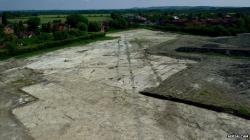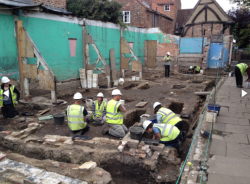INSTITUT SUPERIEUR D'ANTHROPOLOGIE
INSTITUTE OF ANTHROPOLOGY
ONLINE COURSES / COURS A DISTANCE
FALL TERM : OCTOBER 2014
REGISTER NOW
INDE –  Kanpur - A group of children playing on the banks of the Ganga in Kanpur district stumbled upon a pot of coins dating back to the Mughal era. The children were digging when they found the pot that contained 61 silver coins with inscriptions in Arabian and Persian.
Kanpur - A group of children playing on the banks of the Ganga in Kanpur district stumbled upon a pot of coins dating back to the Mughal era. The children were digging when they found the pot that contained 61 silver coins with inscriptions in Arabian and Persian.
http://www.asianage.com/india/children-find-mughalera-coins-kanpur-834?
NEPAL- Lumbini - A pillar-like object dating back to the time of Gautam Buddha has been found at Aama VDC-4 in Lumbini, Rupandehi.Local residents found the object made of bricks and mud on the banks of the Danab River on August 17 and informed the Lumbini Development Trust (LDT) about it. The item had emerged after the river eroded the area. Locals said some vase-like utensils and white and black stones were also found in the area some weeks ago. Bikendranath Lodha, a local, said the area is said to have a settlement named Pamphapur during the Buddha’s time. It was supposedly wiped out after the river changed its course. Archaeologists who carried out an excavation in 1964 had said the area might have had a settlement in the past. Locals believe more archaeological remains may be discovered if an excavation is carried out there.
http://www.thejakartapost.com/news/2014/09/14/buddha-era-relic-revealed.html?
ROYAUME UNI – 
 Aston Clinton - Archaeologists have uncovered the remains of a Roman settlement on a site earmarked for a new development. A University of Leicester team excavated a nine-acre site in Aston Clinton, Buckinghamshire, as a condition of the planning permission for 48 homes. As well as dwelling remains, it found the line of a Roman road and burials. It is within the Icknield Belt, a corridor known to have been favoured for settlement in prehistoric and later periods. A Roman road, Akeman Street, also runs through the centre of Aston Clinton. The council's archaeological planning officer, Eliza Alqassar, said the excavations revealed an Iron Age-Romano-British settlement, human burials and a "substantial trackway" which appeared Roman because it was "straight and defined by ditches". When viewed on maps of the county it appears to align with the projected course of the Lower Icknield Way and so may have origins in the Iron Age or earlier, she said.
Aston Clinton - Archaeologists have uncovered the remains of a Roman settlement on a site earmarked for a new development. A University of Leicester team excavated a nine-acre site in Aston Clinton, Buckinghamshire, as a condition of the planning permission for 48 homes. As well as dwelling remains, it found the line of a Roman road and burials. It is within the Icknield Belt, a corridor known to have been favoured for settlement in prehistoric and later periods. A Roman road, Akeman Street, also runs through the centre of Aston Clinton. The council's archaeological planning officer, Eliza Alqassar, said the excavations revealed an Iron Age-Romano-British settlement, human burials and a "substantial trackway" which appeared Roman because it was "straight and defined by ditches". When viewed on maps of the county it appears to align with the projected course of the Lower Icknield Way and so may have origins in the Iron Age or earlier, she said.
http://www.bbc.com/news/uk-england-beds-bucks-herts-29170434
ROYAUME UNI -  York - Archaeologists at a site in York have found glass, tiles, pots, pipes and human remains.Members of the Archaeology Live dig at All Saints Church in North Street has recently found items dating back to the 12th century, including cattle horn and skull fragments which were by-products of leather production from the early 19th century. During the dig, international volunteers helped identify a grave from the 19th century, along with other finds – including shards of pots and tiles – which suggest the site could have held a building, and the team hoped their analysis could help clear up the history of the dig. The spokesman said: “The grave cut the team were investigating proved to be a number of intercutting infant and juvenile grave cuts. Unlike the adult graves that all appear to respect each other’s position, the burials of the younger individuals seem to have been crammed into this area, cutting through pre-existing burials.
York - Archaeologists at a site in York have found glass, tiles, pots, pipes and human remains.Members of the Archaeology Live dig at All Saints Church in North Street has recently found items dating back to the 12th century, including cattle horn and skull fragments which were by-products of leather production from the early 19th century. During the dig, international volunteers helped identify a grave from the 19th century, along with other finds – including shards of pots and tiles – which suggest the site could have held a building, and the team hoped their analysis could help clear up the history of the dig. The spokesman said: “The grave cut the team were investigating proved to be a number of intercutting infant and juvenile grave cuts. Unlike the adult graves that all appear to respect each other’s position, the burials of the younger individuals seem to have been crammed into this area, cutting through pre-existing burials.
http://www.yorkpress.co.uk/news/11472012.Grave_finds_at_York_archaeological_dig/
ROYAUME UNI –  Hallaton - Centuries-old skeletons holding hands have been uncovered at a “lost” chapel by archaeologists. The remains, of a man and a woman, were found at the Chapel of St Morrell, an ancient site of pilgrimage in Hallaton. Tiles from a Roman building, were found underneath the chapel.Leading the project is professional archaeologist Vicky Score, of the University of Leicester, who works on the project during her holidays. She said carbon-dating on nine skeletons uncovered since the dig began had revealed them to be from the 14th century. It is believed the pair holding hands are of a similar age. The skeletons have been removed to the university for further investigation. Vicky said some of the nine skeletons had stones placed on top of their bodies. “This was a tradition popular in eastern Europe with the idea of keeping the dead down,” she said. Vicky said the earliest mention of the chapel in Hallaton was in a will of 1532. The chapel was located after research by local historian John Morrison. Saint Morrell became the 4th Bishop of Anjou, France, in the year 430. John said: “We think he was brought over in 1170 with the Anjou people, when that area of France became united under Henry II – the first of the Plantagenets.” In 1622, a writer was noting that within living memory “multitudes came to Hallaton chapel to be cured”. The Iron Age Hallaton hoard, including a Roman helmet and coins, was discovered 14 years ago about 500 metres away.
Hallaton - Centuries-old skeletons holding hands have been uncovered at a “lost” chapel by archaeologists. The remains, of a man and a woman, were found at the Chapel of St Morrell, an ancient site of pilgrimage in Hallaton. Tiles from a Roman building, were found underneath the chapel.Leading the project is professional archaeologist Vicky Score, of the University of Leicester, who works on the project during her holidays. She said carbon-dating on nine skeletons uncovered since the dig began had revealed them to be from the 14th century. It is believed the pair holding hands are of a similar age. The skeletons have been removed to the university for further investigation. Vicky said some of the nine skeletons had stones placed on top of their bodies. “This was a tradition popular in eastern Europe with the idea of keeping the dead down,” she said. Vicky said the earliest mention of the chapel in Hallaton was in a will of 1532. The chapel was located after research by local historian John Morrison. Saint Morrell became the 4th Bishop of Anjou, France, in the year 430. John said: “We think he was brought over in 1170 with the Anjou people, when that area of France became united under Henry II – the first of the Plantagenets.” In 1622, a writer was noting that within living memory “multitudes came to Hallaton chapel to be cured”. The Iron Age Hallaton hoard, including a Roman helmet and coins, was discovered 14 years ago about 500 metres away.
http://www.leicestermercury.co.uk/1-000-year-old-skeletons-holding-hands/story-22904104-detail/story.html